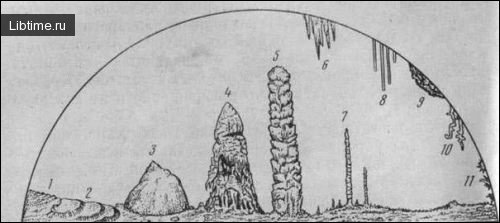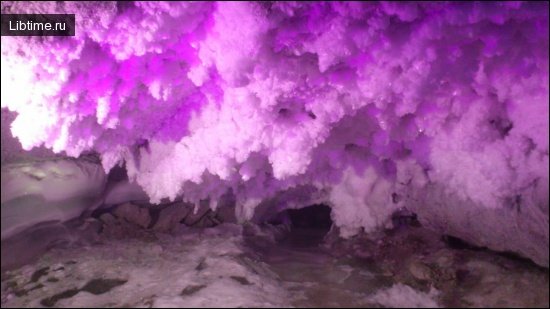Ural caves
The Ural Mountains, stretching in a relatively narrow strip from the cold shores of the Kara Sea in the north to the hot semi-deserts in the south, are characterized by a significant distribution of underground karst cavities, which allows us to consider the Urals as a large zoning unit - a speleological country. 
On the eastern slope of the Urals and in the Trans-Ural region underground karst forms are less pronounced, and in the central most elevated parts of the Urals they are almost non-existent.
In speleological terms, the best studied are the Northern, Middle and Southern Urals, which, according to the complex of karst-forming factors, the nature of cave distribution, and morphological peculiarities, are distinguished as separate regions.
The North Urals speleological area, stretching from the middle reaches of the Shchugor River to the upper reaches of the Kosva River, is subdivided into two provinces: West North Urals and East North Urals.
The West-North Urals speleological province is characterized by a significant distribution of karst caves. About 110 caves have been described here. The largest of them are Divya (length 3240 m), Bolshaya Medvezhya (480 m), Unyinskaya (390 m) and Velsovskaya (170 m).

The cave is dry, with poorly developed natellite formations. The northernmost site of Upper Paleolithic man in the world was discovered at its entrance. The Big Bear Cave is the northernmost location of cave bear bones.
The Eastern North Urals speleological province is located on the eastern slope of the Northern Urals. In the valleys of the Lozva, Ivdel, and Kakva rivers, about ten small caves have been described, confined to limestones of the Middle Paleozoic. The largest of them is the three-storied Svetlaya cave, 110 m long and 20 m deep, near the Vsevolodo-Blagodatsky settlement.
Ice formations remain in one of its grottoes throughout the year. The Middle Urals speleological region, occupying the middle, most depressed part of the Ural Mountains, is characterized by a wide distribution of underground karst cavities developed in Paleozoic carbonate rocks.
Within the region there are two speleological provinces: West-Middle Urals and Middle Urals. The West-Middle Urals province is located on the western slope of the Middle Urals.
148 karst caves have been described here. The largest of them are Shemakhinskaya (length 1660 m), Shemakhinskaya II (more than 1200 m), Kizelovskaya (800 m), Bolshaya Makhnevskaya (570 m), Druzhba (500 m), Kizelovskaya Medvezhskaya (390 m), Pashinskaya (377 m), Arakaevskaya (345 m), Temnaya (300 m) and Mariinskaya (270 m).
In the Sredne-Zauralskaya speleological province, on the slopes of the Neiva, Rezha, Pyshma, Kunara, Iseti, Kamenka and Bagaryak valleys, more than 70 caves have been noted. The largest of them - Smolinskaya - is located on the right bank of the Iseti River, 18 km above the town of Kamensk-Uralsky.
The cave is two-storied. Its total length is 500 meters. The height of some grottoes reaches 8.5 m, and the width - 15 m. 
The West-South Urals province is characterized by a wide distribution of karst caves confined to carbonate and sulfate rocks of the Paleozoic.
Notable among them are Sumganskaya (8000 m long), Kutukskaya IV (1500 m), Sukhoatinskaya (1150 m), Chabaevsky (1000 m), Novomuradymovskaya (903 m), Kutukskaya-Stalactitovaya (800 m), Ignatovskaya (545 m), Laklinskaya (350 m), Sokolinaya (340 m), Minkskaya (295 m), Muynak-Tash (250 m), Ikinskaya (225 m) and Ust-Katavskaya (220 m).
The deepest karst mine is Minyarskaya, which is a vertical cavity 1.5 m in diameter and 90 m deep. Kutukskaya III also belongs to the deep natural mines. Its depth is 80 meters.
Sumganskaya cave, the largest in the Urals, occupies a special position on the western slope of the Kibiz ridge, 12 km west of Maksyutov. There are also very interesting and other caves of the Urals: Sukhoatinskaya Cave, Chabaevsky Cave, Maksimovich Cave.
In the Central South Ural province caves are developed in strongly dislocated and metamorphosed rocks of the Lower Paleozoic and Precambrian.
There are 38 caves explored here, including Khlebodarovskaya (2854 m long), Kapova (1900 m), Maksimovich (1250 m), Temirovskaya (1200 m), Zhemchuzhina (260 m) and Cosmonauts (230 m).
The Khlebodarovskaya cave is located in the foremost ridges of the Southern Urals. It is confined to Devonian and Carboniferous limestones. The entrance is at the bottom of a karst sinkhole.
Grottoes and passages of the cave are stretched along tectonic cracks of northwest and northeast directions. The cave is dry. There are poorly developed nalecic formations. The total length of the cave (according to E. S. Sharov) is 2854 meters. 

It is characterized by large grottoes and wide passages. The total length of the cave is 1900 meters. The cave is richly decorated with calcite natellite formations. In winter, ice stalactites and stalagmites are formed in its near part.
Ancient drawings of a horse, a mammoth and a rhinoceros dating back to the Upper Paleolithic period (20 thousand years ago) were found in the Kapova Cave.


